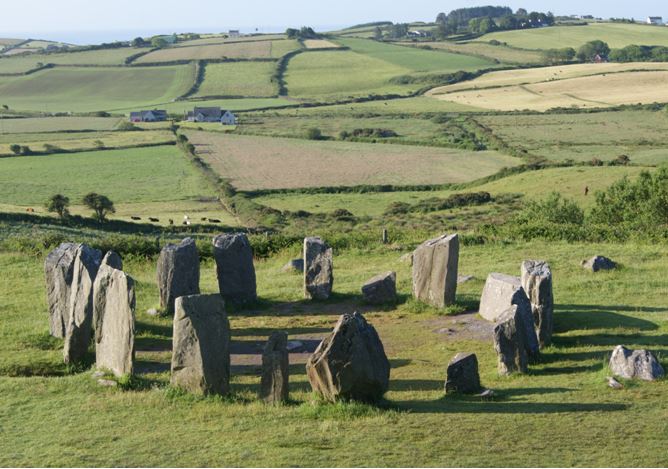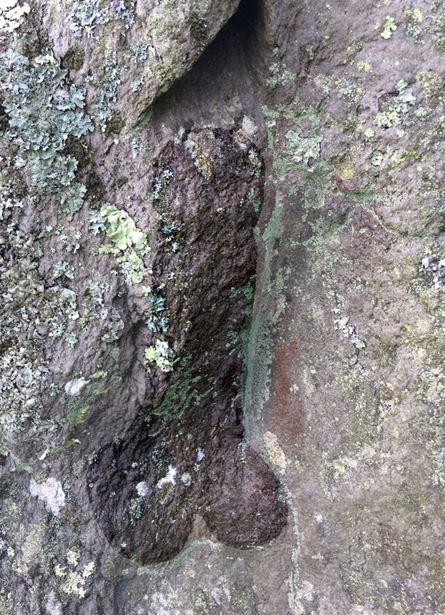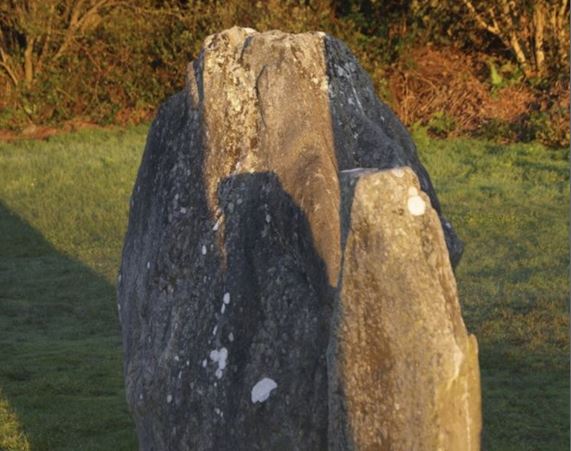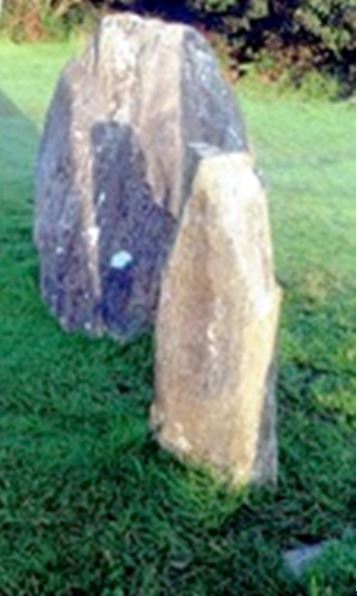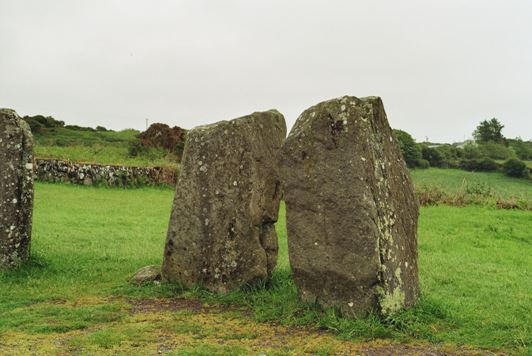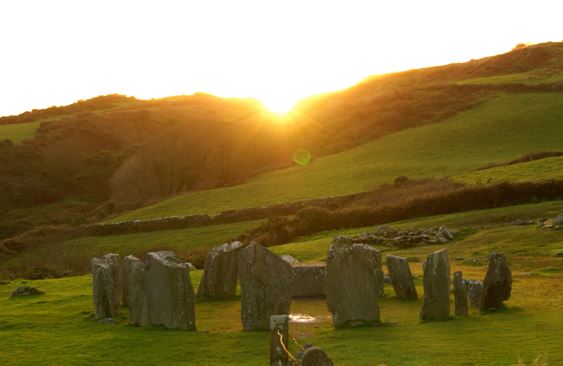Dr Terence Meaden’s Research into the Core Meaning of Axial and Recumbent Stone Circles.
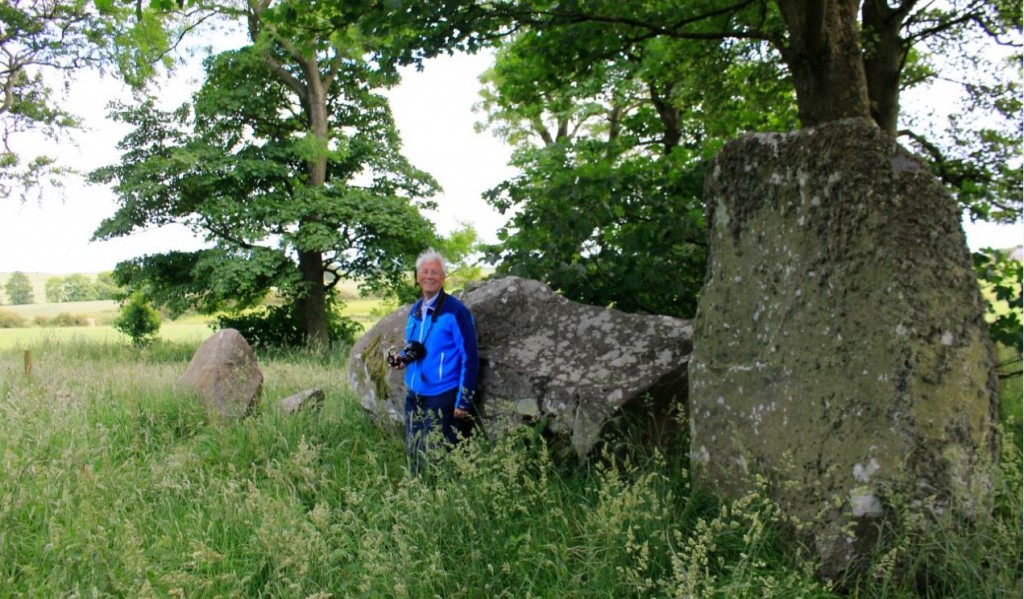
WRITTEN BY Austin Kinsley ON 24/03/19. Dr Terence Meaden’s Research into the Core Meaning of Axial and Recumbent Stone Circles. POSTED IN Recumbent Stone Circles
Part 1: The March and September Quarter Dates
A guest post prepared by Dr G. Terence Meaden mid-March 2019
Advances in archaeoastronomy are announced that introduce a new approach to examining the axial and recumbent stone circles of Ireland and Scotland by studying them at sunrise on what are deduced preplanned dates built into the monuments. Since 2012 research has advanced swiftly on several fronts and in this first article for Silent Earth the studies are illustrated with reference to the splendid Drombeg Stone Circle in County Cork, South-West Ireland (Figure 1).
HOW TO STUDY RECUMBENT STONE CIRCLES
Until now most megalith-archaeoastronomy enthusiasts stood at the geometrical centre of recumbent stone circles gazing at their compass and the recumbent stone opposite them, hoping to spot something of significance related to solar, lunar, planetary or stellar connections. Nothing much was ever found. At best, lunar solutions were offered, as at Aikey Brae (NJ 959471) in Scotland where Burl (1995: 93) wrote that the recumbent “is quite well aligned on the major southern moonset”. Well, this extreme lunar position, reached only every 18.6 years, can hardly be a meaningful reason for pitching a 21-tonne stone in a direction such that this direction aligns with it so rarely. In any case, it is the only such circle. What about all the others? Any attempt at a lunar solution is even less likely to explain Midmar Kirk, also in Aberdeenshire, where Burl (1995: 104) suggests the recumbent “faces not the major but the minor southern moonset, a lunar event much more difficult to detect”.
Elsewhere Burl firmly claims that recumbent stone circles have “nothing to do with the sun” and further writes (Burl 2000: 227) that, in general, “The sun was almost entirely disregarded by the builders of these rings. Midwinter sunrise around 139º [in northern Scotland] was well to the north of 157.5º and its [midwinter solar] setting near 222º occurred in the wide gap between the moon’s major and minor settings.”
Prof. Ruggles (1999: 100-101), in publications commencing 1981, concluded much the same for both the Scottish and the Irish stone circles: “There is no astronomical pattern to them.”; “They “bear no consistent relationship with any specific astronomical body or event.”; “we can say little with conviction about their orientations”; and “Certainly there is no simple interpretation.” In short, whether for Ireland or Scotland, no purposeful worthwhile celestial explanations have ever been forthcoming at any of the dozens of recumbent axial stone circles.
But why hasn’t a positive explanation been found previously?
Answer: Most academic predecessors have often gone on the wrong dates, usually at the wrong time of day, and stood in the wrong place (like the circle centre), facing the wrong way.
So, as regards previous academic opinion about the conclusion that the sun has nothing to do with the answer, the truth is exactly the opposite and specifically, these multiple-stone circles, each with a recumbent stone, have everything to do with the sun when viewed at its rising, as long as one knows where to stand and what to watch for.
This has been proven by assiduous research and appropriate photography over the last seven years and is ever being further tested and clarified. When doing this work, I have been increasingly helped by additional photography from independent investigative friends who appreciate the reasons for getting to the sites by dawn. This means we can now fathom what the farming communities, designers, and builders had planned all those years ago, and we know why. In those ancient days, workers laboured all the hours of daylight. They were up at dawn in all seasons, summer and winter, unlike the majority of people these days. Twenty-first century fact-finders must be at the megaliths for sunrise, and in the summer this can mean 4 a.m. in Aberdeenshire, and 5 a.m. in southern Ireland and southern England.
So sunrise was the time of day planned into the stone monuments, in particular for the days that we may call target dates, for they were the likely festival dates of prehistory. These occur at intervals of 45 or 46 days, commencing with the winter solstice. The target dates, then, are 21 December, 5 February, 22 March, 6 May, 21 June, 6 August, 21 September, and 5 November. Day counting was readily done by notch marking and counting using tally sticks.
At sunrise, we observers watch the appearance of shadows and appreciate their beauty and movement during the first minutes after the emergence of the sun. I have witnessed such shadows dozens of times at stone circles in Ireland and Scotland, and, since September 2016, so has Austin Kinsley and some others. Occurrences were identified and photographed at numerous locations. Typical as type-sites are Drombeg in County Cork (Meaden 2016, 2017a), Loanhead of Daviot in Scotland, and Stonehenge in England (Meaden 2016, 2017b). Many other studies will be reported and described in due course, including, yes, Stonehenge, in that Stonehenge counts as a recumbent stone circle too. This is because its ‘Altar Stone’ lies recumbent, waiting for an annual reunion with the shadow of the Heel Stone, which happens in the week of midsummer solstice. A separate article will deal with this.
DROMBEG STONE CIRCLE AT SUNRISE
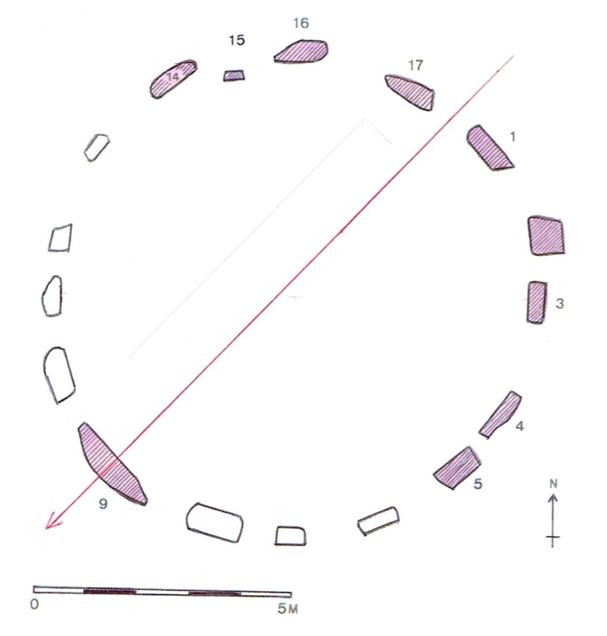
Figure 2. Drombeg Stone Circle showing the principal axis which bisects the portal-stone gap. The two stones that receive all the sunrise shadows are Stone 9 (the recumbent) and Stone 14 (the lozenge stone).
In every example, at every significant date of the annual round, there are always two crucial stones: one active, causing a moving shadow; the other passively waiting. A fertility religion is at once suspected. The passive stone has a shape symbolizing the female gender. It is the stone waiting to receive an active male shadow from a phallic-shaped shadow-casting stone. This union by male shadow between male and female stones works only at or close to the dates given above. Drombeg serves well for explanatory purposes (Figures 1 and 2).
On its recumbent stone is a carving of a vulva emphasizing the stone’s femininity (Figure 3). This stone is the passive stone waiting for the calendrical events of the summer half of the year. Another female stone at Drombeg is a receptive stone shaped like a lozenge, and similar to the lozenge stone at East Aquhorthies in Aberdeenshire. Both serve the same purpose: the waiting female stone and the shadow-casting male symbolic stone doing duty for the festival dates of the winter half of the year.
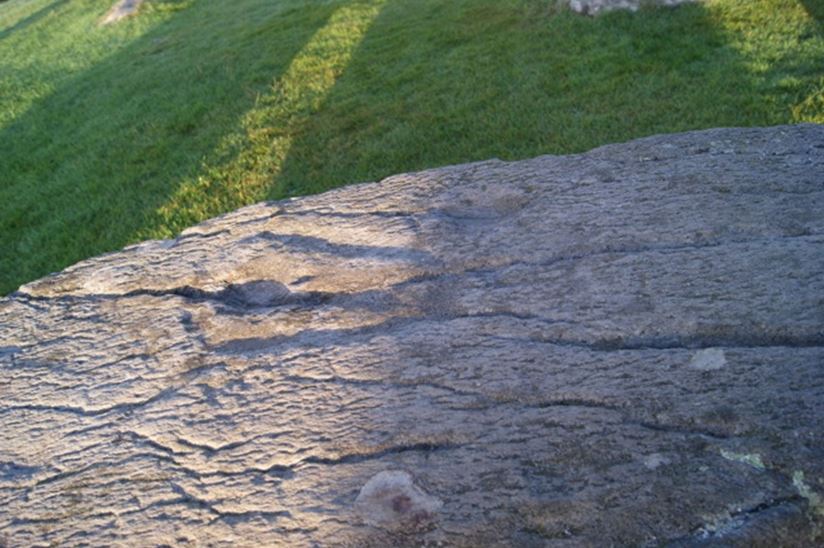
Figure 3. The carved vulva at Drombeg: the mating shadow is moving aside after its sunrise union with the carving on the recumbent stone 9. The date of this photograph was the Lughnasadh occasion in August 2013 which is the same at Beltane.
Stones casting the pertinent dramatic shadows have male characteristics. They are tall, straight, and narrow; that is, narrower than they are high, while female stones are wider than they are high. All recumbent stones have the basic quality of femininity, and at Drombeg, the carved vulva transmits this image forcefully. Additionally, tall stones standing on each side of the female recumbent stone (as at Drombeg and the Scottish circles) powerfully demonstrate the male principle. At Loanhead of Daviot (Figure 4), the phallic stones had been topped by glans-shaped stones. The Irish axial circles have portal stones that are tall and narrow.
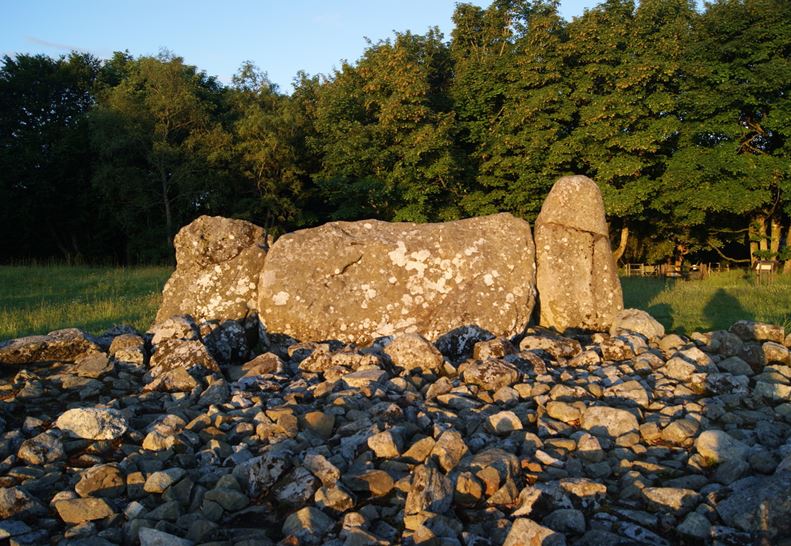
Figure 4. Loanhead of Daviot: a female recumbent stone flanked by two male stones. The western flanker is topped by a stone like a glans. The eastern glans is missing.
At Drombeg, one of several shadow-casting stones has a meaningful erect phallus with testicles carved on it (Figure 5). This was first spotted by Austin Kinsley in 2017. It is on portal stone 17 (Figure 1).
Next, we look at Drombeg in relation to a proposed Neolithic/Bronze Age 365-day calendar, to find what happens at and close to 22 March (Day 92) and 20 September (Day 274) every year. These dates correspond to a sunrise azimuth of 88-89 degrees east of north, and lie midway between the dates of the winter solstice (Day 1) and summer solstice (Day 183).
Note how close these dates and directions are to the equinoxes, which modern astronomers can calculate with precision to obtain the dates for equal days and nights. The stone circle builders were not able to make such calculations. They had no clocks to evaluate timings to within minutes, but they could easily operate a calendar by day-counting with a tally stick. Therefore we should stop talking about so-called equinoxes when considering events and aspects of the Megalithic Age and replace the word with a more appropriate vocabulary. So, just as we use the terms midwinter and midsummer to specify the solstices (Days 1 and 183), we would do better to say midspring (Day 92) and midautumn (274) instead of the March and September ‘equinoxes’. By day-counting, the ancients would have celebrated their festivals on the same dates annually. In contrast, today’s enthusiasts keep changing the date of the equinoxes from among 20-22 March and 20-22 September. The same problem is encountered when allowing the winter solstice (Day 1) to switch between 21 and 22 December, and, occasionally, 20 December.
ACTION AT SUNRISE ON THE SPRING AND AUTUMN QUARTER DATES AT DROMBEG
Important symbolic events take place at Drombeg at the midspring and midautumn quarter dates. A lozenge and a pillar stone stand adjacent, but they are cleverly offset just a little, such that at these dates the rising sun creates a male shadow cast by the male pillar which beautifully unites with the middle of the symbolically female lozenge stone.
First, look carefully at the plan of Drombeg Stone Circle (Figure 1). At the quarter dates, two remarkable dramas take place simultaneously in different arcs of the circle.
To understand this, begin by considering the relative emplacements of the northern stones in the plan as presented in Figure 6.
Below: Figures 7 and 8. Lozenge Stone 14 receives the male shadow at midspring and midautumn.
Exquisite is the resulting union between male and female stones made possible by the medium of subtle shadow-casting (Figures 7 and 8). Lozenge stones have been conventionally female-symbolic (Fahy 1959; Keiller and Piggott 1936) since the Neolithic.
Second, at Drombeg, also on these same spring and autumn dates, another significant male-to-female union takes place at the recumbent stone. The situation again involves union by shadow, this time arising from the device of notch and crevice between two stones (those numbered 4 and 5 in the plan, Figures 1, 9, 10, 11)).
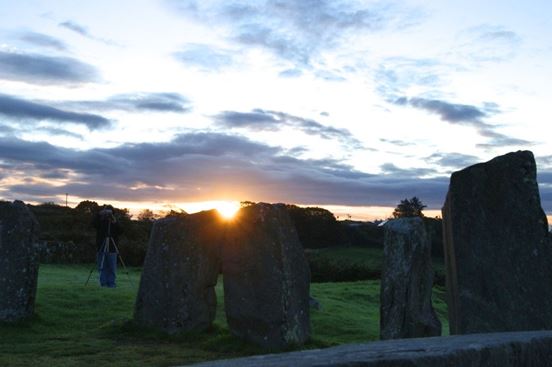
Figure 10. Stones 4 and 5, when viewed from the carving on the recumbent stone, present a notch through which the sun rises on the spring and autumn quarter days.

Figure 11. September Quarter Day 2012: notice how the light through the crevice reaches the recumbent stone and that there is a spot of light on top
What happens next is that the sun rises and shines through the notch and the vertical fissure between perimeter stones 4 and 5 to create a spot of light on top of the recumbent stone at the carved vulva, while a vertical line of light reaches its front side.
At the winter solstice sunset at Drombeg there is a variation on the theme. The union is effected between Sun and Earth, in other words a male sun (as an epiphany of Father Sky) and the female landscape, the realm of the Earth Mother or Goddess as the sun sets at a V-shaped notch on the hill (Figure 12).
From traditional age-old sources in the Indian subcontinent, we know that such a V-notch is a feminine attribute of the hilly landscape (Subhashis Das 2014: 32-34 ).
SHADOW-CASTING AT OTHER MAJOR DATES
Photographs of sunrises and shadows at Drombeg have been achieved at other key dates of the year, namely, Imbolc, Beltane, Lughnasadh, Samhain, and the summer and winter solstices. The author hopes to present proof with photographic detail in another Silent Earth blog.
CONCLUSIONS
Much care was taken by the Megalithic Age planners of recumbent stone circles to create a union by male shadow between male and female stones that the community could witness on days ‘predicted’ by the priest or priestess or shamans. The choice of shape and positions of stones were important. What did they signify?
The simple answer is that the design developed from a community’s belief in hierogamy, when the Sky makes union with Earth as part of a fertility religion. That is to say, the summer solstice is the portentous moment of the year for the occasion of the consummation of the classic Marriage of the Gods, uniting the Sky Father with the Earth Mother. The act of consummation between stones representing divinities was devised as an action spectacle.
By linking features that symbolize the sexes, interpretation is viewed through the concept and desire for fertility—an understandable core feature of life for hardworking farming communities. The vision was heartening for the labouring farmers, who toiled hard and suffered the vicissitudes of changing fortune according to the times of arrival of seasonal and unseasonal weather.
What had been intelligently built into monuments long ago using symbolic artistry and cosmic motion is now being clarified by interdisciplinary analyses in the twenty-first century. Currently, the author is analyzing fieldwork data that he has collected at 24 Irish and 10 Scottish recumbent stone circle sites.
Together with other studies involving 80 Wessex Neolithic long barrows in their local landscapes, this work has helped to reconstruct a day-by-day, whole-year calendar for the Neolithic and Bronze Ages. The author’s research into stone circles began 36 years ago and is appearing as a series of volumes beginning with the all-colour 228-page book, Stonehenge, Avebury and Drombeg Stone Circles Deciphered, published in 2016 with its day-by-day Neolithic Calendar appendix. (A review of the book by Simon Banton is here).
The late Professor Geoffrey Wainwright wrote to the author in September 2016: “I have read the volume with great pleasure. I found it a very stimulating book, full of good ideas which made me think more deeply about the reasons which lie behind the planning of these monuments about which you write so eloquently. I hope that the book does well. It deserves to do so.”
Additionally, two long papers have been peer-reviewed and published in the Scottish Archaeological Journal of the Edinburgh University Press (Meaden 2017).
Three papers in the academic journal Expression (number 15 (March 2017), number 16 (June 2017) and number 20 (June 2018), are downloadable from the Internet.
Acknowledgments: I thank the megalith enthusiasts who have helped me with fieldwork over the years, including especially John Davies (Clonakilty), Professor John Atkins (Dunmanway), Austin Kinsley (Bournemouth) and Ebor Benson (County Cork).
REFERENCES
Burl, H.A.W. (1995). A Guide to the Stone Circles of Britain, Ireland and Brittany. Yale University Press, New Haven and London.
Burl, H.A W. (2000). The Stone Circles of Britain, Ireland and Brittany. Yale.
Das, S. (2014). Unknown Civilizations of Prehistoric India. Kaveri Books, 4832/24, New Delhi, 110 002, India.
Fahy, E.M. (1959). A recumbent stone circle at Drombeg, County Cork (Excavation report). Journal of the Cork Historical and Archaeological Society. Vol. 64, pp. 1-27.
Keiller, A. and Piggott, S. (1936). The West Kennet Avenue, Avebury: Excavations 1934-1935. Antiquity. Vol. 10, pp. 417-427.
Meaden, G.T. (2016). Stonehenge, Avebury and Drombeg Stone Circles Deciphered. Lambert Academic Publishing, Bahnhofstrasse 28, 66111 Saarbrucken, Germany, here.
Meaden, G.T. (2017). Drombeg Stone Circle, Ireland: Design plan analyzed with respect to sunrises and lithic shadow-casting for the eight traditional agricultural festival dates and further validated by photography. Journal of Lithic Studies, Edinburgh University. Vol. 4, number 4, 5-37.
Ruggles, C.L.R. Astronomy in Prehistoric Britain and Ireland. Yale University Press.

